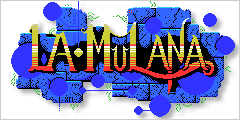La-Mulana
| La-Mulana | |
|---|---|
 |
|
| Developer(s) |
|
| Publisher(s) | |
| Designer(s) | Takumi Naramura |
| Platform(s) | |
| Release date(s) |
Microsoft Windows
|
| Genre(s) | Platform-adventure, Metroidvania |
| Mode(s) | Single-player |
La-Mulana (stylized as La•Mulana) is a platform-adventure video game, initially designed to imitate the look and feel of the MSX games. First released on May 27, 2005 in Japan for Microsoft Windows, the game was originally only available in Japanese, but an English translation patch has been produced by Ian Kelley of AGTP. The game was later remade for the ground up in a 16-bit style for the Nintendo Wii, and later PC, Mac, Linux and PlayStation Vita.
The protagonist of the game is Lemeza, a whip wielding adventurer similar to Indiana Jones exploring the tomb within La-Mulana. Although there is only one ending in the game there are many ways to get there, in that completing objectives in the game (gaining power ups and reaching new areas) is not linear, nor is there an obvious recommended path to take. Many powerups will allow the player to reach new areas (similar to Super Metroid), but the game gives no indication of where to go.
Since the game was intended as a tribute to the MSX games of the 1980s (and especially to Maze of Galious), it uses the 16-color palette and low resolution typical of those games. Also, the opening sequence parodies the typical load screen of the MSX, displaying the amount of available video RAM and a copy of the MSX logo. The protagonist also has a laptop MSX in his possession throughout the game, and can collect or buy ROM cartridges for it; many of these can be combined to produce various special effects.
Initially, the protagonist is only equipped with a whip, and has a small amount of vitality. Items in the game help advance the plot, some of which do not grant any abilities, but open up a new area or allow another item to be taken. Other items, however, do grant the protagonist abilities, and some are also required to access new areas of the game.
Most non-boss enemies in the game will not cause a lot of damage to the protagonist, however there are very few ways to restore life, and in many cases getting hit will cause the protagonist to fall off a hard-to-reach ledge and lose significant progress. An item in the game is available early on that enables teleportation back to the start (the location of the game's only save point) in addition to various waypoints. As explained in the game's manual, the general strategy of the game is to explore and solve as many puzzles as possible before getting low on life and teleport back when the risk of death becomes too great. However, actions taken in certain rooms can make it very difficult to return after warping out, so warping out is not always the wise action.
...
Wikipedia
